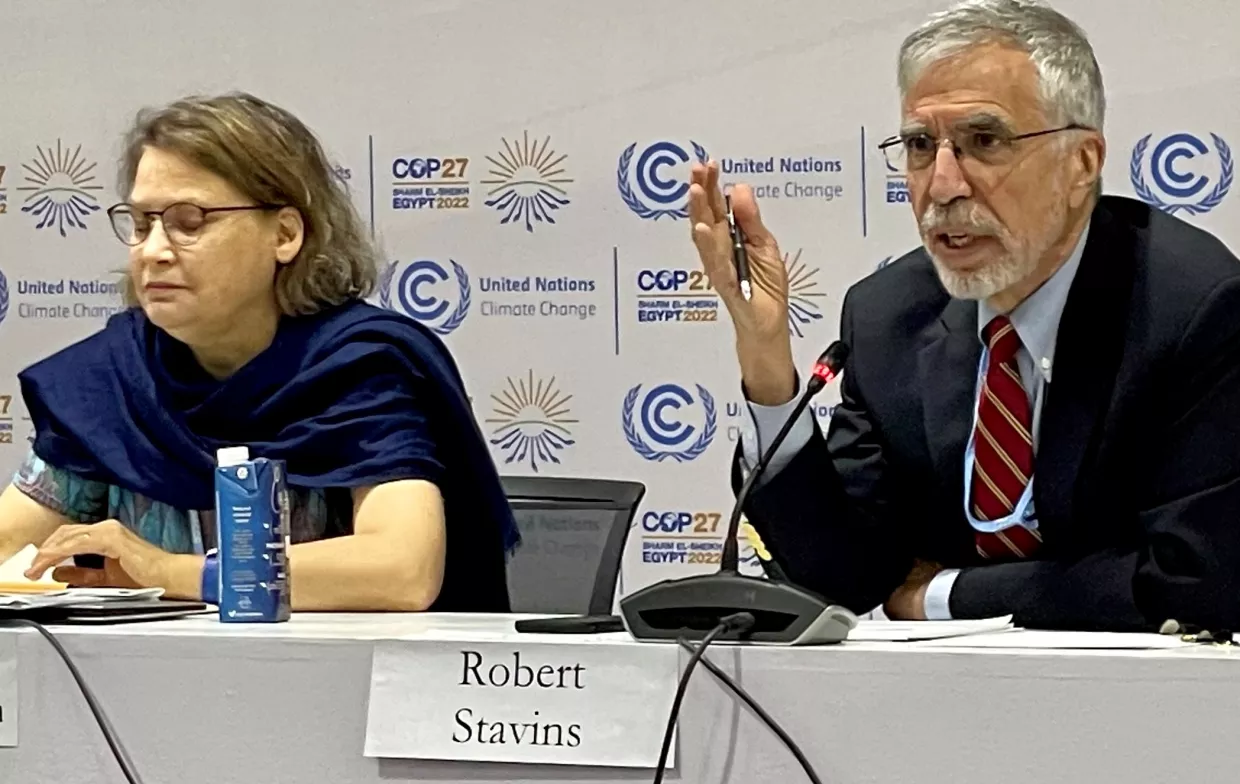
Significant technological advances in satellite technology and atmospheric measurements have greatly enhanced the understanding of methane concentrations and emissions. The dynamic ways in which those advancements are allowing researchers to monitor methane emissions down to the source level was the focus of discussion Thursday (November 17) at a COP-27 side event co-hosted by the Harvard Project on Climate Agreements (HPCA), the Enel Foundation, and the government of Mexico.
The panel session, titled “Using Satellite Observations of Atmospheric Methane to Advance Global Climate Change Policy,” was hosted and moderated by HPCA Director Robert Stavins and featured Daniele Agostini, Head of Energy and Climate Policies, Enel Group; Lena Höglund-Isaksson, Senior Research Scholar, International Institute for Applied Systems Analysis (IIASA); and Daniel Jacob, Vasco McCoy Family Professor of Atmospheric Chemistry and Environmental Engineering, Harvard University.
Stavins opened the event by summarizing recent policy developments, including the launch of the Global Methane Pledge at COP-26 in 2021, in which leaders of 125 countries have volunteered to cooperate in a collective effort to reduce methane emissions 30% below 2020 levels by 2030. He also referenced the $1.5 billion grant intended for state and local institutions to reduce methane emissions in the oil and gas sector, as well as a fee on methane emissions from oil and facilities that exceed regulatory requirements to be finalized in the spring of 2023, contained in the U.S. Inflation Reduction Act (IRA).
Höglund-Isaksson, who has studied inventories of methane emissions for more than 20 years, stressed the critical importance of accurate measurements to arm policymakers with the data they need to properly analyze and regulate methane emissions.
“An important factor for fast action on methane emissions is that the targeted stakeholders agree on a common set of information. This is particularly important when addressing methane emissions because these are much more uncertain than the carbon dioxide emissions from fuel use which can be relatively easily estimated if you know the carbon content of the fuel, but such a simple relationship does not exist for methane,” Höglund-Isaksson said. She argued that ‘bottom-up’ emission inventories, based on detailed calculation of the emissions from all the individual sources of an area, can serve as a check and improve the accuracy of ‘top-down’ emissions estimates, typically derived from nationwide calculations.
Jacob, a renowned expert on the development of powerful inverse methods to infer methane emissions from satellite observations of concentrations, underscored the urgency of measuring and regulating global methane emissions down to the source level.
“Methane concentrations in the atmosphere have been increasing rapidly over the past decade and that increase has been accelerating,” he said. “The acceleration in the past few years is really interesting. 2020 and 2021 had the largest methane increases on record which would be very unsettling if it was due to anthropogenic conditions, but we think it’s due to tropical wetlands, which is very interesting because of the implications in terms of the response of wetlands to climate change.”
Jacob and his team at Harvard have created an Integrated Methane Inversion (IMI) open-access cloud-based platform for stakeholders, with plans for enhanced data measurements from new satellites in the coming years.
Agostini lauded the work of Jacob and other researchers, stating that emitters need unequivocal data to make critical decisions about their energy portfolios moving forward.
“Methane plays a very important role in contributing to climate change, so the fact that there is so much attention that has recently been paid to it is very good news,” Agostini remarked. “The fact that we don’t have clear baselines [on methane emissions] is a real issue, so for some stakeholders it is hard to assess the emissions contained in their pledges. However, the pledges contain some strong reductions which can only be welcome, so we are very happy to see these baselines be consolidated and to see the numbers and to put in place the instruments to measure them.”
The panelists responded to numerous questions from audience members, and Stavins concluded the event by outlining the new Jacob-Stavins methane initiative at Harvard, and the role it will play in making methane data widely available to policymakers and other interested parties.
“We are going to be active, not passive, and that means that we will be communicating the results to major stakeholder organizations, to the 194 parties to the Paris Agreement, to the Global Methane Pledge, to departments and agencies and political people in Washington D.C. and possibly in other relevant countries. This is a big part of our initiative,” he said.
Stavins analyses international methane reduction efforts in a recent paper, “International Cooperation to Reduce Methane Emissions,” co-authored by HPCA co-director Robert Stowe and Harvard Kennedy School student Adriana Melchor.
See a video of the COP27 side event here: https://www.youtube.com/watch?v=H-bJHW5vANI.
For more on the Harvard Project’s activities at COP-27, see our Tumblr page: https://www.tumblr.com/hpcaatcop27
Gavel, Doug. “HPCA Co-Hosts Important COP-27 Side Event on Measuring Methane Emissions to Advance Global Climate Policy.” November 21, 2022
